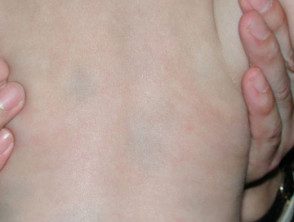Lumbosacral dermal Melanocytosis or Mongolian spot is a blue-gray skin mark that generally affects the lumbar and buttock region of newborns. It is a common form of birthmark.
What is lumbosacral dermal melanocytosis like?
Lumbosacral dermal melanocytosis presents as bluish-gray patches on the lower back or buttocks. Dermal melanocytosis can also affect other sites such as the face or extremities. The patches are usually a few centimeters in diameter, but larger ones may appear. The affected skin does not thicken or change in any way other than color.
Lumbosacral dermal melanocytosis

Lumbosacral dermal melanocytosis. Mongolian place

Lumbosacral dermal melanocytosis. Mongolian spots.

Congenital nevus
What is the cause of dermal melanocytosis?
Dermal melanocytosis is thought to be due to entrapment of melanocytes (pigment cells) in the dermis of the developing embryo, when the cells have not been able to reach their proper location in the epidermis.
The patches are present at birth and occur in more than 90% of children of the Mongoloid race (e.g., East Asians, Polynesians, Indonesians, Micronesians). They occur less frequently in other breeds.
What is the treatment for dermal melanocytosis?
Dermal melanocytosis is benign and does not require treatment. The discoloration usually disappears spontaneously by the time the child reaches 4 years old. Persistent dermal melanocytosis tends to be larger and persist for many years or indefinitely.
